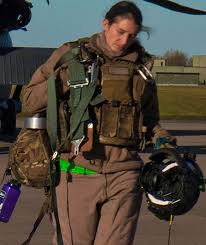Afton Marie Thornton Ponce was born on February 22, 1985 in Lebanon, Oregon, the daughter of Rhonda M. Kline and Therien M. Thornton. She was a 2003 graduate of Priest River Lamanna High School and joined the Air Force in 2004. She was assigned to the Honor Guard and served in more than 490 ceremonies at Arlington National Cemetery. She eventually retrained to become an aerial gunner and moved to Nellis Air Force Base, Nevada. Assigned to the 56th Rescue Squadron at RAF Lakenheath, England, she was killed during an HH-60G Pave Hawk helicopter crash while performing a low-level training mission on the Norfolk coast, Jan. 7, 2014. A small flock of geese that had migrated to a new area caused the HH-60G to crash off the English coast, killing the four airmen aboard.
Helicopter crews at Lakenheath receive multiple reports on bird hazards, from the U.K. Ministry of Defense and local wildlife volunteers. They track where flocks have been and areas of high risk. A report from earlier that month showed low bird activity in the area over Cley Marshes. Another report from December showed moderate activity at dusk in an area east of where the crew would be operating.
Volunteers had counted about 400 geese, along with other birds in the region. The plan was to arrive at the landing zone at 5:56 p.m., an hour and 44 minutes after sunset and an hour after the moderate bird hazard warning expired.
The crew took off from RAF Lakenheath at 5:33 p.m., flying to a reserved training area northeast of the base near the English coastline. They donned night vision goggles and flew low, conducting simulated threat countermeasures on their way to rescue the simulated downed F-16 pilot.
Twenty-five minutes into the flight, Jolly 22 and the flight lead arrived at the planned location and entered an orbit in accordance with regular rescue procedures. Winds picked up, coming in at 210 degrees at 20 knots, gusting to 31, and pushing the HH-60s toward the town of Blakeney. This caused a problem with local noise regulations, and the crews were ordered to a new mission area about 1.3 miles north and near the coastline.
While the helicopters stayed clear of the Blakeney Reserve, which has reported high bird activity, it sent them close to Cley Marshes in the Wildlife Trust.
What the reports didn’t reflect was that a storm surge the month before had pushed birds away from the Blakeney Reserve and into the Cley Marshes on the coastline, where the Pave Hawks were headed.
At the new location, the formation flew two left orbits. The pilot verified the status of the simulated down pilot and then the aircraft was ordered to a landing zone about 3.5 miles away. The two aircraft flew along the coastline at about 110 knots, at about 110 feet above ground level. Pedro 22 was about 10 seconds behind the flight lead.
The sounds of the Pave Hawks approaching likely startled a group of geese in the marsh, and they took off. No one in the flight lead helicopter saw any birds through their night vision goggles.
About 2.5 miles away from the landing zone, the flock of geese slammed into Jolly 22. Two smashed through the windscreen, knocking out the pilot, Stover, and copilot, Ruane. Another struck and knocked the gunner, Ponce, unconscious.
“The types of geese that hit the [helicopter] weigh between 6 and 12 pounds,” the report states, noting that the birds hit the helicopter at a force of 130 knots. “A bird weighing 7.5 pounds would impact with 53 times the kinetic energy of a baseball moving at 100 miles per hour.”
One bird hit the nose of the helicopter, disabling the trim and flight path stabilization systems — key components of the aircraft’s control system. With no pilots able to take control, and the automatic control systems damaged, the stick of the aircraft was able to move randomly. Accident Investigation Board President Brig. Gen. Jon Norman wrote in the report that Mathews, the sole conscious crew member, did not have time to assess the critical situation because it happened so quickly.
The aircraft began a rapid left roll and lost vertical lift. At 6:05 p.m. — three seconds after the bird strikes — the Pave Hawk crashed into the Cley Marshes. Wreckage covered about 180 feet of the coastline. The crew died on impact.
Almost immediately after impact, the flight lead helicopter reported that Jolly 22 was no longer visible. The chopper stopped all training, attempted to contact the other crew by radio, and climbed to a safe altitude. With no response, they circled back and noticed a fire. They landed about 3 minutes and 30 seconds after the crash and discovered the remains of the crew.
The remains were transferred to a local hospital and then flown to Dover Air Force Base, Del., with full military honors. SSgt Ponce is now buried Priest River, Idaho, with an additional headstone in a family plot in Clark Fork Cemetery, Idaho.
Source of information: www.findagrave.com

